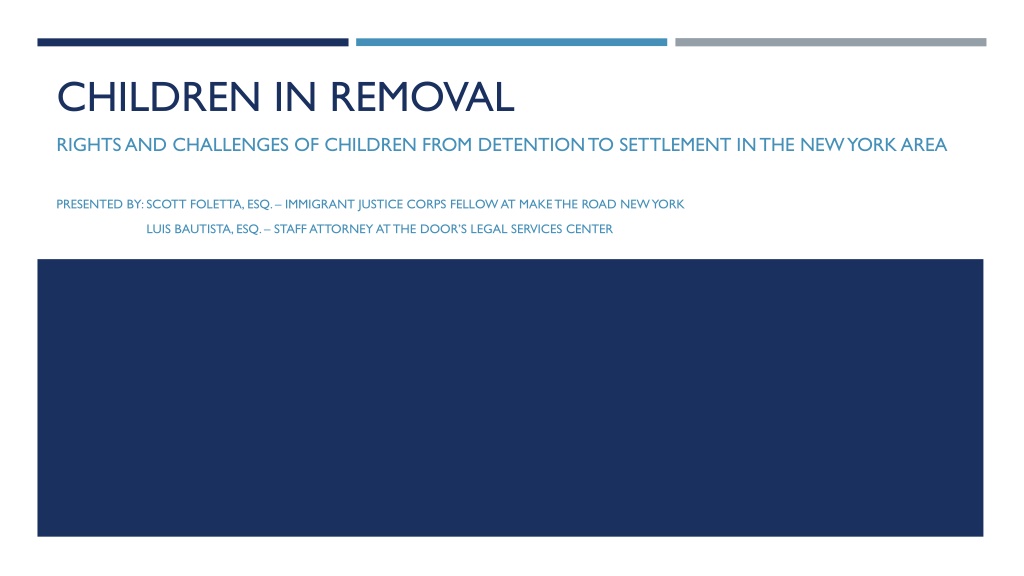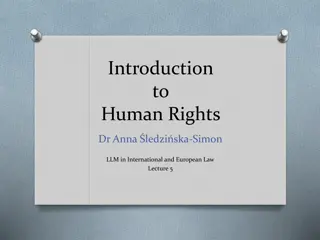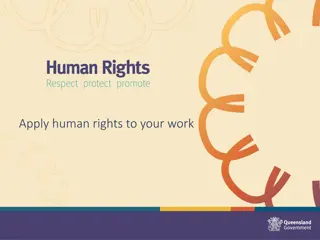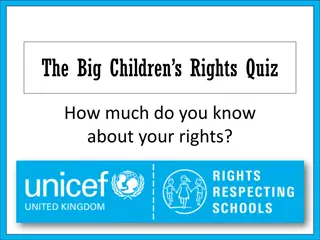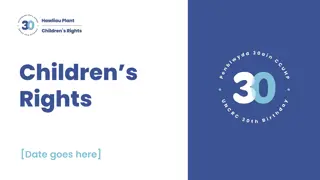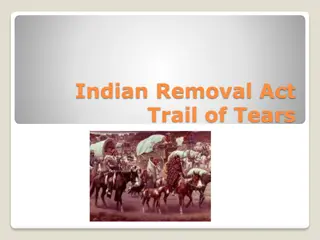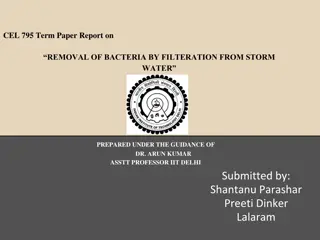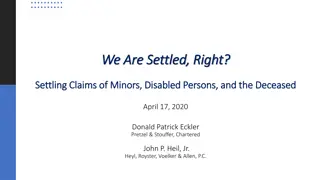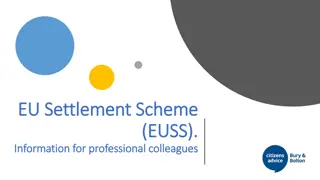Challenges and Rights of Children in Removal Process and Settlement in New York
The presentation covers the journey of unaccompanied children entering the U.S. via the U.S.-Mexico border, the involvement of governmental agencies, detention, placement, care, release to sponsors, and appearances in immigration court. It also discusses identifying rights violations, services outside of legal contexts, and specific case studies highlighting the needs of children in the New York City area.
Download Presentation

Please find below an Image/Link to download the presentation.
The content on the website is provided AS IS for your information and personal use only. It may not be sold, licensed, or shared on other websites without obtaining consent from the author. Download presentation by click this link. If you encounter any issues during the download, it is possible that the publisher has removed the file from their server.
E N D
Presentation Transcript
CHILDREN IN REMOVAL RIGHTS AND CHALLENGES OF CHILDREN FROM DETENTION TO SETTLEMENT IN THE NEW YORK AREA PRESENTED BY: SCOTT FOLETTA, ESQ. IMMIGRANT JUSTICE CORPS FELLOW AT MAKE THE ROAD NEW YORK LUIS BAUTISTA, ESQ. STAFF ATTORNEY AT THE DOOR S LEGAL SERVICES CENTER
AGENDA Part I: U.S and Mexico Border Detention of Unaccompanied Children General overview: What happens when an unaccompanied child enters the U.S via the U.S-Mexico border? Governmental agencies that have contact with Unaccompanied Children Apprehension by Department of Homeland Security and role of Office of Refugee Resettlement Unaccompanied Children in immigration detention Intake, Placement, and Care in Office of Refugee Resettlement Custody Release from Office of Refugee Resettlement to a sponsor Appearance in Immigration Court and immigration case outcome Part II: How to determine if an Unaccompanied Child s rights have been violated and Services to Unaccompanied Children outside of Legal Context How to identify if a child has been released to a sponsor Sponsor point of view What questions to ask in order to determine if a child s rights were violated during immigration detention Case Study of Manuel Case Study of Miguel Discussion of services and programming that a child released to a sponsor in the New York City area will require
WHAT HAPPENS WHEN AN UNACCOMPANIED CHILD ENTERS THE U.S VIA THE U.S-MEXICO BORDER Unaccompanied Alien Child: Office of Refugee Resettlement (ORR) and Department of Homeland Security (DHS) apply definition found in the Homeland Security Act. An unaccompanied alien child is a child without lawful immigration status in the U.S, under 18 years old, and has no parent or legal guardian in the country present or available to provide care and physical custody. Homeland Security Act of 2002 Section 279(g)(2). Apprehension by DHS and referral to ORR: A UAC s contact with DHS begins when they are apprehended by federal authorities Customs and Border Patrol (CBP), U.S Coast Guard, or Immigration and Customs Enforcement (ICE) on suspicion of violating immigration law. There can be two methods by which an UAC can enter the immigration system: Apprehension by Border Patrol or detained at port of entry 1. Internal apprehension by local, state, or federal authorities 2.
APPREHENSION BY BORDER PATROL OR DETAINED AT PORT OF ENTRY Four possible scenarios: 1. IF unaccompanied, under 18, and Mexican or Canadian 2. IF unaccompanied, under 18, and NOT Mexican or Canadian 3. IF accompanied, under 18, and Mexican or Canadian 4. IF accompanied, under 18, and NOT Mexican or Canadian These scenarios were as a result of the following events: Flores Settlement Set national standards regarding the detention, release, and treatment of all children in DHS custody. Homeland Security Act of 2002 (HAS) HAS eliminated the U.S. Immigration and Naturalization (INS), which held unaccompanied children in its custody. The William Wilberforce Trafficking Victims Protection Reauthorization Act (TVPRA) of 2008.
FIRST SCENARIO: IF UNACCOMPANIED, UNDER 18, AND MEXICAN OR CANADIAN DHS may initiate voluntary return process to Mexico or Canada; OR if child does not consent, possible trafficking victim, or has a credible fear of persecution then they are placed back into the system until there is an immigration case outcome.
SECOND SCENARIO: IF UNACCOMPANIED, UNDER 18, AND NOT MEXICAN OR CANADIAN Two simultaneous processes may begin: DHS initiates removal proceedings Immigration case can yield the following outcomes: 1. Removal order Voluntary departure Immigration relief Termination of proceedings Transfer to ORR/ DUCS (Division of Unaccompanied Children s Services) custody UAC is to receive secure care. The following may happen while in ORR/DUCS facility: 2. UAC is released to sponsor There is a change or transfer of custody UAC turns 18 years old Post-18 placement Transferred to DHS custody UAC absconds from facility
THIRD SCENARIO: IF ACCOMPANIED, UNDER 18, AND MEXICAN OR CANADIAN Final Outcome: Child is removed with parent or guardian.
FOURTH SCENARIO: IF ACCOMPANIED, UNDER 18, AND NOT MEXICAN OR CANADIAN UAC is placed in family detention, while DHS initiates removal proceedings with one of the above mentioned immigration case outcomes possible. Important to note that protections afforded to children pursuant to DHS policies, federal regulations, and the Flores settlement are applicable to a child detained with a parent or legal guardian in a family detention facility.
INTERNAL APPREHENSION BY LOCAL, STATE, OR FEDERAL AUTHORITIES Immigration enforcement authorities (ICE), acting through ICE s Enforcement and Removal Operations (ERO), apprehend children in the US during worksite enforcement actions or through operations to combat smuggling and human trafficking. Also, unaccompanied children may be arrested by state or local law enforcement agency and ICE may be alerted and a detainer may be place on the child. This is not unique to children as it happens to adults as well. These internal apprehensions also lead to DHS custody. These internal apprehension by local, state, or federal authorities usually lead to the same outcomes; Voluntary departure a) Removal order b) Immigration relief c) Termination of proceedings d)
GOVERNMENTAL AGENCIES THAT HAVE CONTACT WITH UNACCOMPANIED CHILDREN Three overall government agencies have contact with unaccompanied alien children: Department of Homeland Security (DHS) 1. Customs and Border Protection (CBP) Immigration and Customs Enforcement (ICE) Enforcement and Removal Operations (ERO) Office of the Principal Legal Advisor (OPLA) The exclusive legal representative for the U.S government in exclusion, deportation and removal proceedings before the U.S Department of Justice s Executive Office for Immigration Review. OPLA has 26 offices throughout the U.S, each headed by a Chief Counsel. ICE Trial Attorneys Citizenship and Immigration Services (CIS) Asylum Office Department of Health and Human Services (DHHS) 2. Administration for children and Families (ACF) Office of Refugee Resettlement (ORR) Anti-Trafficking In Persons Division (ATIP) Division of Refugee Assistance (DRA) Unaccompanied Refugee Minor Program (URM) Division of Unaccompanied Children s Services (DUCS) Department of Justice (DOJ) 3. Executive Office for Immigration Review (EOIR) Board of Immigration Appeals (BIA) Office of the Chief Immigration Judge (OCIJ) Immigration Courts
APPREHENSION BY DEPARTMENT OF HOMELAND SECURITY AND ROLE OF OFFICE OF REFUGEE RESETTLEMENT In implementing the HSA, DHS assigned its juvenile-related responsibilities to the Bureaus of Customs and Border Protection (CBP) and Immigration and Customs Enforcement (ICE). Both bureaus were given responsibility for apprehending, processing, and transporting unaccompanied alien children. Both CBP and ICE have the authority for making arrests, completing administrative processing, and making initial enforcement determinations, such as repatriations and releases to family members. ICE s Detention and Removal Office (DRO) became responsible for housing juvenile aliens who were apprehended with family members and primarily for transporting apprehended juveniles to longer-term detention facilities.
APPREHENSION BY DEPARTMENT OF HOMELAND SECURITY AND ROLE OF OFFICE OF REFUGEE RESETTLEMENT CONTINUED Border Patrol agents and CBP officers are responsible for apprehending and processing almost all unaccompanied alien children who are attested in the border area or who attempt to enter the United States. During immigration processing, CBP personnel obtain a child s biographical information, perform immigration record checks on all juveniles, and serve relevant documentation on juveniles placed in removal proceedings. Processing of juveniles must comply with Flores, a case that involved unaccompanied children who entered the Unites States without permission and were subsequently detained by the U.S government. Juveniles are the first priority for processing by CBP, taking precedence over adult aliens.
APPREHENSION BY DEPARTMENT OF HOMELAND SECURITY AND ROLE OF OFFICE OF REFUGEE RESETTLEMENT CONTINUED UAC s Access to Legal Counsel The Flores settlement requires that UAC s receive paperwork during processing that adult aliens do not receive, most notably Form I-770, the notice of rights and Request for Disposition.
APPREHENSION BY DEPARTMENT OF HOMELAND SECURITY AND ROLE OF OFFICE OF REFUGEE RESETTLEMENT CONTINUED Pursuant to Flores, the Form I-770 informs UAC s of their rights during the initial processing interview, usually conducted by CBP. Form I-770 informs UAC s of the following rights: Right to use the telephone to call a parent or any other adult relative; 1. Right to be represented by a lawyer; 2. Right to a hearing 3. According to Flores, children who are under 14 years od age, OR are unable to understand the Form I-770m must have the form explained to them in a language and manner they can understand. The I-770 allows UAC s to request, if eligible, more streamlined ways to resolve their immigration cases and to be returned to their native country. These options include accepting voluntary departure, or accepting a Voluntary Return for Mexican or Canadian nationals. Border Patrol agent and CBP officers are instructed to provide UAC s who are placed into immigration proceedings with a list of free legal service providers in the jurisdiction where they are apprehended. The list of free legal service providers is maintained and disseminated by the Executive Office of Immigration Review (EOIR).
APPREHENSION BY DEPARTMENT OF HOMELAND SECURITY AND ROLE OF OFFICE OF REFUGEE RESETTLEMENT CONTINUED According to Flores, a UAC in DHS custody must be placed in an appropriate juvenile facility within 3 days (72 hours) from when CBP or ICE assumes custody. CBP and ICE consider the 3-day standard in terms of 72 hours for the time in hours that elapses between apprehension and longer-term placement, rather than as a calendar day. DHS has a maximum of 5-days to place the juvenile in a longer-term detention facility if the juvenile was apprehended in an area without bed space in a DRO-approved facility (for accompanied children) or in an ORR- approved facility (for unaccompanied children).
APPREHENSION BY DEPARTMENT OF HOMELAND SECURITY AND ROLE OF OFFICE OF REFUGEE RESETTLEMENT CONTINUED The implementation of the HSA transferred responsibility for the care and housing of unaccompanied juvenile aliens to the Office of Refugee Resettlement (ORR). ORR is responsible for the care and placement of unaccompanied juveniles, including facility placement decisions, oversight and monitoring of facility contracts for housing unaccompanied children, running immigration and criminal checks on potential sponsors of unaccompanied children to whom they may be released, release to a sponsor pending immigration proceedings, and transportation of juveniles for medical reasons, court appearances, or transfers to subsequent facilities.
INTAKE, PLACEMENT, AND CARE IN ORR CUSTODY ORR Processing Intake o Assessment of basic and immediate care needs and potential sponsors Admission assessment o Performed by social worker within 3 to 7 days of admission o Includes biographic, family, legal/migration, medical, substance abuse, and/or mental health history Psychosocial assessment and individualized service plan o Performed by master s-level social worker within 21 days of admission Search for sponsor o Begins within 24 hours of admission
INTAKE, PLACEMENT, AND CARE IN ORR CUSTODY Types of ORR Facilities (Child should be placed in least restrictive detention setting appropriate to that child s age and special needs) Shelter o Minimally restrictive o Primarily children without special needs or a history of contact with the juvenile or criminal justice systems o The majority of children in ORR custody are in shelter care (based on most recent data) Staff-secure o Children with a history of nonviolent or petty offenses or are determined to present an escape risk Secure o Children with a history of violent offenses or who are determined to pose a threat to themselves or others Transitional foster care o Children younger than 13, sibling groups with one child younger than 13, pregnant and parenting teens, and children with special needs are prioritized for short-term placement with a foster family
INTAKE, PLACEMENT, AND CARE IN ORR CUSTODY Requirements of Care in ORR Facilities Classroom education Health care Socializing/recreation activities Vocational training Mental health service Assistance with family reunification
RELEASE FROM ORR TO A SPONSOR Potential Sponsors (Order of Preference) Parent Legal guardian Adult relative Adult designated by parent Licensed program (such as a shelter for homeless youth) Other adult/entity approved by ORR, but NOT adult partner
RELEASE FROM ORR TO A SPONSOR Process of Release to Sponsor Sending a family reunification packet Verification of family relationship, legal status, employment status, motivation for sponsorship, ability to address needs, home environment Fingerprint check Interview of child, sponsor, and/or parents Home assessment in special cases Facility recommendation to ORR ORR approval or denial Sponsor signs agreement assuming care
APPEARANCE IN IMMIGRATION COURT AND IMMIGRATION CASE OUTCOME Juvenile Docket vs. Surge / Priority Docket Surge docket o Unaccompanied minors from Guatemala, Honduras, and El Salvador who entered during or after summer of 2014 o Cases fast-tracked and prioritized above other cases Juvenile docket o All other unaccompanied minors
APPEARANCE IN IMMIGRATION COURT AND IMMIGRATION CASE OUTCOME Common Forms of Relief Special Immigrant Juvenile Status Asylum, withholding of removal, relief under the Convention Against Torture U nonimmigrant status/T nonimmigrant status
APPEARANCE IN IMMIGRATION COURT AND IMMIGRATION CASE OUTCOME Results of Immigration Proceedings Relief Removal order > removal Voluntary return Termination Prosecutorial discretion/administrative closure
APPEARANCE IN IMMIGRATION COURT AND IMMIGRATION CASE OUTCOME Termination/Suppression Arguments Improper service (challenges to the Notice to Appear) Denial of alienage (challenges to the I-213) Regulatory violations Egregious or widespread Fourth Amendment violations Fifth Amendment violations Violations of the Flores settlement and other binding policies
APPEARANCE IN IMMIGRATION COURT AND IMMIGRATION CASE OUTCOME Denial of Alienage DHS has the burden of establishing alienage in removal proceedings Advocates can attempt to suppress DHS evidence and thereby terminate proceedings The arresting officer s notes on Form I-213 are typically used as proof of alienage in absence of a birth certificate or passport The I-213 is considered inherently trustworthy , but only absent any evidence that [it] contains information that is inaccurate (Gomez-Gomez, 23 I&N Dec. at 524; Ponce-Hernandez, 22 I&N Dec. at 785) Look for inaccuracies, inconsistencies, lack of detail, or information gathered from sources other than the child
APPEARANCE IN IMMIGRATION COURT AND IMMIGRATION CASE OUTCOME When a Regulatory Violation Warrants Termination The violation is egregious or undermines reliability of evidence Rajah v. Mukasey, 544 F.3d 427, 440 (2d Cir. 2008) The violation causes the client prejudice The regulation was promulgated to protect a fundamental right Waldron v. INS, 17 F.3d 511 (2d Cir.1993) o But see: Nolasco v. Holder, 637 F.3d 159 (2d Cir. 2011) despite violation, DHS provided the substantive notice required by the regulation (service of NTA), and the child appeared in immigration proceedings and conceded proper service Rajah v. Mukasey pre-hearing rights vs. hearing rights
APPEARANCE IN IMMIGRATION COURT AND IMMIGRATION CASE OUTCOME Common Regulatory Violations 8 CFR 103.8(c)(2)(ii): Service of Notice to Appear o Additional requirement for service on person with whom a child under 14 lives o Service on sponsor after release from ORR 8 CFR 236.3(h): Service of Form I-770 o Explained in a language the child understands if child is under 14 or does not understand the written notice o DHS should give the child time to read before signing, provide a copy after signing, and do so before interviewing the child 8 CFR 1240.10(a): Service of List of Pro Bono/Low Bono Providers
PART II: HOW TO DETERMINE IF AN UNACCOMPANIED CHILD S RIGHTS HAVE BEEN VIOLATED AND SERVICES TO UNACCOMPANIED CHILDREN OUTSIDE OF LEGAL CONTEXT
HOW TO IDENTIFY IF A CHILD HAS BEEN RELEASED TO A SPONSOR A potential sponsor may be contacted to provide proof of relationship with the child, fingerprints for a background check, and other information relevant to sponsorship Sponsor will be given an ORR Verification of Release with child s photo, biographic information, and name and address of sponsor Sponsor will be given a copy of the Sponsor Care Agreement describing sponsor s responsibilities
WHAT QUESTIONS TO ASK IN ORDER TO DETERMINE IF A CHILDS RIGHTS WERE VIOLATED DURING IMMIGRATION DETENTION Circumstances of Arrest How arrested What child was doing when arrested Where child was arrested Number of officers present Whether force was used Whether child was scared during arrest and why How the child was transported Whether handcuffs were used Where child was taken after arrest
WHAT QUESTIONS TO ASK IN ORDER TO DETERMINE IF A CHILDS RIGHTS WERE VIOLATED DURING IMMIGRATION DETENTION Circumstances of Detention Where child was held What the facility looked like Who the child was held with (adults/children) Temperature in the cell Ability to sleep at night, excessive noise at night Access to a mattress and pillow Amount and quality of food Injuries or sickness in detention, whether anyone was made aware, and what resopnse Whether medical care was available or received How much time did the child spend at each stage of detention (the icebox / hielera , other DHS detention facility, and ORR shelter)
WHAT QUESTIONS TO ASK IN ORDER TO DETERMINE IF A CHILDS RIGHTS WERE VIOLATED DURING IMMIGRATION DETENTION Circumstances of Interrogation Did child understand what was happening Did child feel he/she had to answer officer s questions Who else was present during interrogation Where the interrogation occurred Whether the door was open, or the child was free to leave, or felt free to leave What child thought would happen if he/she did not answer questions Whether the officer promised or threatened anything as a consequence of answering or not answering questions Language spoken by the officer and fluency, or whether an interpreter was used What questions were asked by the officer and child s responses
WHAT QUESTIONS TO ASK IN ORDER TO DETERMINE IF A CHILDS RIGHTS WERE VIOLATED DURING IMMIGRATION DETENTION Rights Advisals and Forms Whether child was told of his/her rights to an attorney, phone call, lawyer, a hearing before and immigration judge, and to communicate with his/her consul Whether child was allowed to make a phone call Whether child was asked to sign papers without understanding them Whether child can read, and was able to read the papers he/she signed Whether child was read the contents of the papers in a language he/she understands Whether child was given the papers before or after interrogation Whether child was given a copy of the papers he signed, and when (after signing them or only at time of release from ORR) Whether child still has all the papers he signed Whether the child recognizes an I-770 or NTA What identity documents the child had on his person when arrested
WHAT QUESTIONS TO ASK IN ORDER TO DETERMINE IF A CHILDS RIGHTS WERE VIOLATED DURING IMMIGRATION DETENTION Circumstances of Release How child was transported to the point of release Where child was released to sponsor What documents were given to immigration by the child or sponsor What documents were given to the child and to the sponsor by immigration How these documents were given (in person, by mail) Who gave these documents to the child/sponsor and when
WHAT QUESTIONS TO ASK IN ORDER TO DETERMINE IF A CHILDS RIGHTS WERE VIOLATED DURING IMMIGRATION DETENTION In addition to questioning the child and sponsor, consider sending FOIA requests to EOIR, ORR, CBP, ICE and USCIS as necessary (omitting any statement about the child s alienage on the forms) Review the Notice to Appear, I-213, and I-770 for errors
WHAT QUESTIONS TO ASK IN ORDER TO DETERMINE IF A CHILDS RIGHTS WERE VIOLATED DURING IMMIGRATION DETENTION Service Issues The child, the ORR sponsor, and/or the parent did not receive a copy of the NTA The NTA s certificate of service does not show service on all parties as required by regulations and case law (for example, no adult was served with the NTA for a child under 14) DHS s only purported service of the ORR sponsor was to tell the child to give a copy of the NTA to the sponsor DHS attempts to perfect service in court, in violation of 8 CFR 1003.14(a) (NTA service must be properly executed prior to filing the NTA with the court) The NTA contains the wrong name or other basic identifying, biographical information describing the child The NTA fails to allege sufficient facts to establish the child s alienage or removability The NTA filed with the court does not bear the original signature of an officer with the authority to issue the NTA under 8 CFR 239.1(a) The NTA was issued without a date or time for removal proceedings and was not followed up by a hearing notice as required under 8 CFR 1003.18(b)
WHAT QUESTIONS TO ASK IN ORDER TO DETERMINE IF A CHILDS RIGHTS WERE VIOLATED DURING IMMIGRATION DETENTION I-770 Issues DHS did not give the child an I-770 (even if it served a similar form) DHS did not give the I-770 to the child timely (e.g., provided it after interviewing the child) DHS did not read aloud the I-770 or explain it and the child was either: (1) under 14; or (2) the child was at least 14 and it was clear the child did not understand (e.g., the child obviously could not read what was written, the child had obvious developmental disabilities, the child had obvious psychological issues, or the child obviously was unable to concentrate) DHS gave the child an I-770 written in a language the child did not understand and DHS refused to translate it (e.g., giving something in Spanish to a child who understood only an indigenous language) DHS completed the I-770 in a way that failed to reflect that it followed proper procedures DHS forced the child to sign the I-770 without offering the child any opportunity to read it DHS did not give a copy of the I-770 to the child immediately after the child signed it DHS did not give the I-770 to the child and instead gave it only to the child s guardian or the conservator of the Office of Refugee Resettlement (ORR)-funded shelter where the child was held
CASE STUDY #1: MANUEL Manuel is from Honduras and traveled to the U.S when he was 17-years old. Manuel is 5 5 tall and weighs 115 lbs. Manuel entered the U.S on or around April 2013 with his birth certificate in the back pocket of his pants. Manuel s BC was his only form of identification. However, Manuel fell into the Rio Grande on his trip, while his BC was in his back pocket. Manuel lost the only form of identification he had with him. Manuel, with the help of his brother, hired coyotes that took him to the U.S border within 12 days of leaving his home in Honduras. Manuel was stopped by CBP when he was 17-years old, who did not believe he was 17-years old. Manuel suggested that the agent call his family in Honduras to verify his age, but the agent refused. At first, Manuel was detained in a cold cell with other children. However, Manuel was transferred to another cell where he spent 8-days alone in cells filled with other adult men. Manuel was then informed by an agent that he should sign for voluntary departure if he wanted to return home. The agent had already prepared and printed paperwork for adult detainees. When Manuel informed the agent that she had the correct birth year on the form making him 18, not 17 years old the agent told Manuel that everything would be delated if she had to reprint everything. Manuel felt confused and pressured, so he signed the paperwork.
CASE STUDY #1: MANUEL CONTINUED Having signed for deportation, Manuel was wound through a further maze of cells in the detention center in Texas, culminating in a shower with no privacy in a cell full of adult men. Late one night, Manuel, and those in his cell, were told that they would be returning to their countries. Manuel was shackled with a belly chain around his waist attached to handcuffs around his wrists, and a chain between ankle cuffs. Manuel was put into an airplane and not told where the plane was going. Manuel was taken to New Jersey and was told to await his deportation, which would take place in 5 days. Manuel began to experience acute chest pains and wrote a letter to ICE, informing them of his age and request for medical attention. Manuel saw a doctor after a few hours of writing this latter. At the end of the exam, Manuel told the doctor that he was 17-years old. The doctor told Manuel that he should not be detained with other adults if he was under 18 and said she would speak with agents right away. Manuel was returned to his cell. In the middle of the night, and agent went to Manuel s cell and took him to the agent s office. The agent asked for Manuel s family s phone number in Honduras. Four other agents came into the office and stood around Manuel. Despite the hour, Manuel s brother answered the agent s call and confirmed that Manuel was 17 years old. Upon determining that Manuel was a minor, agents moved him through three different solitary confinement cells. One cell was so small that Manuel could not move around. Manuel had seen people who were fighting to be placed in that cell as punishment. After solitary confinement, Manuel was fingerprinted and processed for release at the detention center. Manuel remained chained as agents took his fingerprints. Manuel was finally released to a children s shelter 8-days after he was detained.
CASE STUDY #1: MANUEL CONTINUED Arguments for termination of removal proceedings: Termination is appropriate when CBP and ICE violated their own regulations while holding Manuel in their custody, depriving Manuel of his fundamental rights, shocking the conscious by their treatment of Manuel, and prejudicing Manuel s right and ability to defend himself in removal proceedings. Violation of Flores Settlement agreement; Violation of the TVPRA with regards to treatment of children; and Violation of 8 CFR 1236.3(g); Complete disregard for the particular vulnerability of the minor by subjecting Manuel to solitary confinement. CBP and ICE ignored vulnerabilities to victimization in adult detention. CBP and ICE ignored Manuel s general vulnerability to Trauma as an adolescent by shackling him for extended periods of time. CBP and ICE violated entire frameworks for treatment of detained immigrant children. Manuel was not given any of the protections or process that DHS is supposed to offer a child. Violation of Fundamental rights CBP and ICE violated Manuel s fundamental right to due process, guaranteed by the 5thamendment.
CASE STUDY #1: MANUEL CONTINUED Outcome of Manuel s case:A motion to terminate removal proceedings was made pursuant to invalid agency action. Manuel s I-360 SIJS application was approved while the motion to terminate was pending. OCC moved for a motion to terminate due to an approved I-360 SIJS application. Motion was not heard and motion to terminate was granted based on approved I-360 SIJS application. Manuel s I-485 application was mailed out last week.
CASE STUDY #2: ALEX Alex is from Guatemala and traveled to the U.S when he was 17-years old, on or around July 2011. Alex s first language is Kaqchikel, an indigenous language spoken in Central Guatemala. Alex s second language is Spanish. Alex had grown up with his mother and never met his father. Alex made the journey to the U.S. alone, without friends or family. It took Alex two months to get to the Mexico-US border. Alex and the group he was traveling with got stopped by CBP. CBP made everyone sit down while they went around from person to person asking questions. When it was Alex s turn, the agent started asking questions in English and gesturing in different ways to get Alex to understand. The agent continued to gesture and point to sheet of papers where the agent was writing down information in order to get Alex to understand. No other agent present went over to try to translate for the agent speaking in English, even though Alex heard other officers speaking Spanish. Another person in Alex s group started translating; however, this person did not speaking English fluently. Alex remembers being confused by this entire interaction because this other person started providing information to the agent that had not been translated or confirmed with Alex. Alex was not provided with a translator during this interaction or a notice of his rights prior to questioning.
CASE STUDY #2: ALEX CONTINUED Alex got released to a cousin in New York and was put into removal proceedings via the juvenile docket at 26 federal plaza. Alex remained in juvenile docket without representation until the end of July 2014 when he came in contact with The Door. Alex was eligible for SIJS via abandonment by his father. USCIS received Alex s I-360 SIJS application a few days before he turned 21 years old. Alex s I-360 application was issued a Notice of Intent to Deny based on information present in the I-213. Specifically, the NOID was citing a statement that they were attributing to Alex in which he said that he lived with both parents prior to leaving Guatemala. In fact, Alex had never lived with his father and the special findings order reflected those facts.
CASE STUDY #2: ALEX CONTINUED Form I-213 Record of Deportable/Inadmissible Alien DHS requires its officers to include in-depth information in a child s I-213. The Juvenile Protocol Manual, created by the Office of Detention and Removal, makes clear that officers should obtain as much detailed biographical information as possible. Officers are instructed to ask the juvenile about 12 topics, directed at the juvenile s vulnerabilities, that are not covered on the I-213 form itself and to add [the resulting information] to the narrative of the I-213 Form. Those topics include: Location of immediate family; Location and phone numbers of any friends or relatives in the US or contiguous territory; Type pf locale in country where juvenile was raised (suburban, rural, urban, etc.); Whom the juvenile has lived with before leaving home; Length of time in transit, from home to the US; Route of travel (e.g., countries, length of time spent in each, status in each, date of arrival at border, etc.); Destination in the US; Person whom juvenile was to contact in the US and phone number; If smuggled, the arrangements made; The health of the juvenile: are there any health related problems admitted? The juvenile s language skills: (1) Spanish, English, etc. (2) speak, read, write, understand?
CASE STUDY #2: ALEX CONTINUED Submitted a response to USCIS that Alex s I-360 SIJS application should be approved because the I-213 is defective and insufficient for the following reasons: The information included in the I-213 did not come from Alex; Material information on the I-213 is incorrect; Wrong DOB; Incomplete name; Incorrect address of cousin in the U.S; Mother s name is incorrect; The I-213 lacks detail, e.g., source of information for I-213 statements not cited, 12 topics not covered in narrative of I-213,complete name of Alex. A temporal gap existed between Alex s interrogation and the creation of the I-213. I-213 s are given a presumption of inherent trustworthiness in part because they are considered documents created in the normal course of business, in accordance with normal recordkeeping requirements. Part of the normalcy of the I-213 is its creation in relatively short order after the immigration officer obtains information on its subject. In the asylum context, DHS has acknowledged that facts may blur when case assessments are written at a time removed from an interview, even later the same day. Alex s I- 213 was created a full day after Alex was apprehended. Alex was not given an I-770 notice of his rights. Those rights include: a) the right to use the telephone to call a parent or other adult relative; b) the right to speak with a lawyer; and c) the right to a hearing in front of an immigration judge. Alex was not given an I-770 notice of his rights in a language he could understand. When a juvenile alien is apprehended, he or she must be given a Form I-770, Notice of Rights and Disposition. If the juvenile is less than 14 years of age or unable to understand the notice, the notice shall be read and explained to the juvenile in a language he or she understands. 8 CFR 236.3(h). Other arguments were made regarding the validity of the Special Findings Order issued by the Family Court and how USCIS was overstepping its function in doing a de novo review of the family court order.
CASE STUDY #2: ALEX CONTINUED Outcome of Alex s case I-360 SIJS application was approved and Alex received his green card in October 2015, 4 years after his arrival to the US.
SERVICES THAT A CHILD RELEASED TO A SPONSOR IN NEW YORK CITY AREA WILL REQUIRE Fiscal year 2014 (October 1, 2013 through September 20, 2014) saw DHS apprehend 68, 541 unaccompanied children at the U.S-Mexico border. New York has received the second highest number of unaccompanied immigrant children after Texas, with 5,955 children settling in New York for fiscal year 2014, as reported by the U.S Department of Health and Human Services. Services that a UAC may require can include: Education Employment Housing and homelessness Healthcare KYR on interactions with law enforcement
